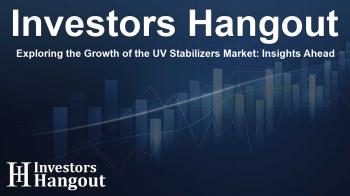Exploring the Growth of the UV Stabilizers Market: Insights Ahead

The Growth of the UV Stabilizers Market
The UV stabilizers market is on an upward trajectory, forecasted to reach a remarkable $3.72 billion by 2030. This significant growth, stemming from $2.53 billion in 2024, indicates a compound annual growth rate (CAGR) of 6.76% from 2025 to 2030. With an increasing demand for material protection across various sectors, the relevance of UV stabilizers continues to surge.
Understanding UV Stabilizers and Their Applications
UV stabilizers are essential additives designed to shield materials from the harmful effects of sunlight and extreme weather conditions. These stabilizers include types such as HALS (Hindered Amine Light Stabilizers), UV absorbers, and quenchers. Industries ranging from automotive to packaging and agriculture rely heavily on these additives to enhance the longevity and appearance of their products. In the automotive sector, manufacturers increasingly seek UV-resistant polymers that ensure durability against outdoor exposure. Similarly, packaging industries benefit from UV stabilizers by extending the shelf life and aesthetic appeal of products in market segments like food and beverages.
The Role of UV Stabilizers in Agriculture
In agriculture, the importance of UV stabilizers cannot be overstated. They play a crucial role in extending the life of greenhouse films, nets, and mulch films, which are regularly subjected to intense sunlight. This durability not only safeguards the materials but also contributes significantly to the efficiency of agricultural practices.
Regional Insights on UV Stabilizers
The Asia Pacific region stands out as a burgeoning market for UV stabilizers. Factors such as rapid industrial growth, urbanization, and the prevalence of plastic-based materials drive the market dynamics here. In contrast, North America and Europe lead in innovation and regulatory compliance, creating a high demand for superior UV stabilization solutions. Companies in these regions are actively engaging in research and development (R&D) initiatives, aiming to strengthen their product offerings and penetrate new markets.
Market Dynamics and Growth Drivers
Consumer awareness regarding material sustainability, coupled with stringent regulations, propels the demand for UV protection across a myriad of industries. As stakeholders recognize the long-term benefits of incorporating UV stabilizers, the market is poised for consistent expansion.
Segmentation by Product Type
The UV absorbers segment is anticipated to be the second fastest-growing segment in terms of market value. This growth is primarily driven by the rising need across sectors like automotive and cosmetics, where UV absorbers serve as effective solutions to block harmful UV radiation. Their adaptability to various polymers and coatings makes them particularly advantageous in applications requiring both aesthetic appeal and durability.
Insights from the Building and Construction Sector
The building and construction sector is noteworthy, having captured the second-largest share of the UV stabilizers market in value terms in recent years. This outcome highlights the increasing preference for materials that offer enhanced durability and protection against environmental elements. Applications such as flooring, roofing membranes, and window profiles utilize UV stabilizers to prevent degradation from prolonged sun exposure, an aspect greatly valued in today's construction needs.
The European Market Landscape
A glance at the European market reveals it as the second-largest for UV stabilizers in terms of value. Steady demand across various applications, including automotive, packaging, and personal care, reflects the region's commitment to product quality and sustainability. Although growth rates are comparatively moderate when juxtaposed with Asia Pacific and North America, the stringent regulations and emphasis on long-lasting UV stabilizer technologies in Europe bolster steady market demand.
Key Industry Players
The competitive landscape features major industry players committed to advancing technology and product capabilities. Companies such as BASF SE, Rianlon Corporation, Suqian Unitech Corp., and others are at the forefront of this market. Their emphasis on innovation drives the sector’s growth, enabling the development of high-performing solutions tailored to meet diverse applications.
Frequently Asked Questions
What is the projected growth of the UV stabilizers market?
The UV stabilizers market is projected to grow to $3.72 billion by 2030.
What are the primary applications of UV stabilizers?
UV stabilizers are used in automotive, packaging, agriculture, personal care, and construction applications.
Which regions are experiencing significant growth in this market?
The Asia Pacific region is rapidly growing, alongside established markets in North America and Europe.
What drives the demand for UV stabilizers?
Demand is driven by increased consumer awareness of sustainability, regulatory pressures, and a focus on product durability.
Who are the key players in the UV stabilizers market?
Key players include BASF SE, Rianlon Corporation, and Suqian Unitech Corp., among others.
About The Author
Contact Kelly Martin privately here. Or send an email with ATTN: Kelly Martin as the subject to contact@investorshangout.com.
About Investors Hangout
Investors Hangout is a leading online stock forum for financial discussion and learning, offering a wide range of free tools and resources. It draws in traders of all levels, who exchange market knowledge, investigate trading tactics, and keep an eye on industry developments in real time. Featuring financial articles, stock message boards, quotes, charts, company profiles, and live news updates. Through cooperative learning and a wealth of informational resources, it helps users from novices creating their first portfolios to experts honing their techniques. Join Investors Hangout today: https://investorshangout.com/
The content of this article is based on factual, publicly available information and does not represent legal, financial, or investment advice. Investors Hangout does not offer financial advice, and the author is not a licensed financial advisor. Consult a qualified advisor before making any financial or investment decisions based on this article. This article should not be considered advice to purchase, sell, or hold any securities or other investments. If any of the material provided here is inaccurate, please contact us for corrections.

